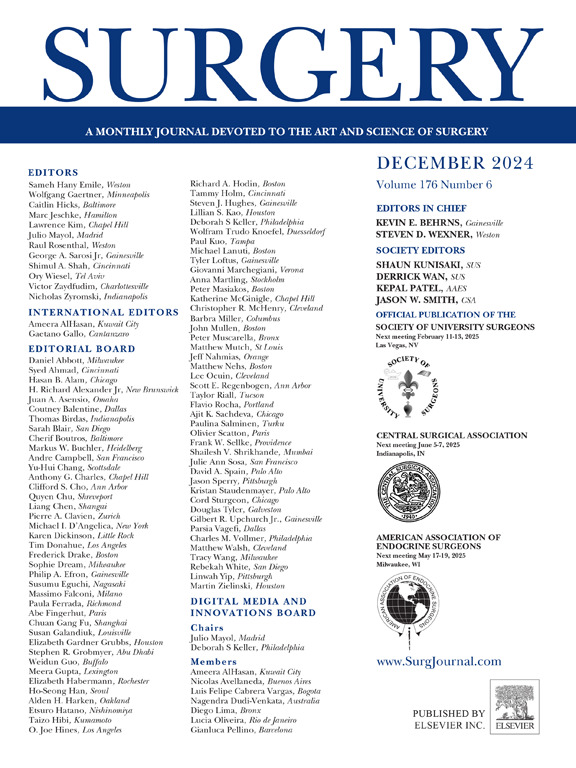胰腺远端切除术是治疗胰颈癌的最佳手术方法吗?
IF 3.2
2区 医学
Q1 SURGERY
引用次数: 0
摘要
背景:胰颈癌的最佳切除术在临床实践中具有挑战性,因为我们可以通过胰十二指肠切除术或胰腺远端切除术进行切除。本研究的目的是评估淋巴结清扫的有效性,并帮助确定胰颈癌的最佳手术治疗方法:我们对2012年至2022年间接受治愈性胰腺切除术的462例胰腺癌患者进行了回顾性评估,其中35例患者患有胰颈癌,且术前无放射学胃十二指肠动脉接触。我们分析了临床病理特征、淋巴结转移部位以及淋巴结清扫的疗效指数,疗效指数是用各部位淋巴结转移的频率乘以各部位淋巴结阳性患者的5年生存率计算得出的:结果:转移率最高的淋巴结站是11号p(28.6%),其次是8号(17.1%)、14号(14.3%)、13号(14.3%)、17号(9.5%)和6号(4.8%)。淋巴结清扫的疗效指数分别为:11 号 14.3,13 号 4.76,14 号 8.57。胰十二指肠切除术和胰腺远端切除术患者的5年无复发生存率和5年总生存率无明显差异(分别为23.7% vs 54.7%,P = .142;29.9% vs 51.1%,P = .179)。单变量生存分析显示,肿瘤大小≥2厘米与预后不良有关(危险比为3.842,P = .009):结论:就淋巴结转移的胰颈癌患者的生存获益而言,伴有#11p淋巴结清扫的PD优于DP。本文章由计算机程序翻译,如有差异,请以英文原文为准。
Is distal pancreatectomy the optimal surgical procedure for pancreatic neck cancer?
Background
The optimal resection for pancreatic neck cancer is challenging in clinical practice because we could dissect by pancreaticoduodenectomy or distal pancreatectomy. The purpose of this study was to evaluate the effectiveness of lymph node dissection and to help determine the optimal surgical treatment for pancreatic neck cancer.
Methods
We retrospectively evaluated 462 patients with pancreatic cancer who underwent curative-intent pancreatectomy between 2012 and 2022, 35 of whom had pancreatic neck cancer without preoperative radiologic gastroduodenal artery contact. We analyzed the clinicopathological characteristics, lymph node metastasis stations, and the efficacy index of lymph node dissection, which was calculated by multiplying the frequency of lymph node metastasis to each station by the 5-year survival rate of patients with positive lymph nodes at each station.
Results
The lymph node station with the greatest rate of metastasis was #11p (28.6%), followed by #8 (17.1%), #14 (14.3%), #13 (14.3%), #17 (9.5%), and #6 (4.8%). The efficacy indices of lymph node dissection were 14.3 for #11, 4.76 for #13, and 8.57 for #14. There were no significant differences in 5-year recurrence-free survival and 5-year overall survival between patients undergoing pancreaticoduodenectomy and those undergoing distal pancreatectomy (23.7% vs 54.7%, P = .142; 29.9% vs 51.1%, P = .179, respectively). Univariate survival analysis showed that tumor size ≥2 cm was associated with poor prognosis (hazard ratio, 3.842, P = .009).
Conclusions
PD with #11p lymph node dissection is preferable to DP in terms of survival benefit for pancreatic neck cancer with lymph node metastasis.
求助全文
通过发布文献求助,成功后即可免费获取论文全文。
去求助
来源期刊

Surgery
医学-外科
CiteScore
5.40
自引率
5.30%
发文量
687
审稿时长
64 days
期刊介绍:
For 66 years, Surgery has published practical, authoritative information about procedures, clinical advances, and major trends shaping general surgery. Each issue features original scientific contributions and clinical reports. Peer-reviewed articles cover topics in oncology, trauma, gastrointestinal, vascular, and transplantation surgery. The journal also publishes papers from the meetings of its sponsoring societies, the Society of University Surgeons, the Central Surgical Association, and the American Association of Endocrine Surgeons.
 求助内容:
求助内容: 应助结果提醒方式:
应助结果提醒方式:


